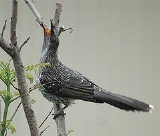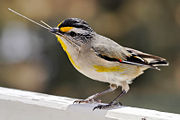
Meliphagoidea
Encyclopedia
Meliphagoidea is a superfamily
of passerine
birds. They contain a vast diversity of small to mid-sized songbird
s widespread in the Austropacific region. The Australian Continent
has the largest richness in genera
and species
.
et al.. A more modern definition of a monophyletic Meliphagoidea based on cladistic analysis was made by ornithologists at the American Museum of Natural History
.
 The Sibley-Ahlquist taxonomy
The Sibley-Ahlquist taxonomy
controversially redefines the families Acanthizidae
(spinebills) and Dasyornithidae (bristlebirds) as subfamilies within the larger family Pardalotidae (pardalotes). However later work indicated that the Pardalotidae are more closely related to the Meliphagidae (honeyeaters) and could be considered a subfamily within them. The Acanthizidae have also been traditionally considered aberrant honeyeaters, and could also be considered a subfamily of Meliphagidae; however, they seem to be very ancient members of Meliphagoidea and if the pardalotes are separated as a distinct family apart from Meliphagidae, the spinebills might be split off too. But some ornithologists maintain that separating the spinebills and pardalotes into separate families would mean creating two monotypic
families with a mere six species in total, and so keeping the spinebills within the Meliphagidae and possibly merging the pardalotes therein as well seems to be a more sensible course of action.
The Sibley-Ahlquist taxonomy
also placed the Petroicidae
(Australasia
n "robins") in the Meliphagoidea. This is now no longer favoured; as more recent work show that they form a distinct lineage of uncertain relationships; all that can be said at present with reasonable certainty is that the Petroicidae are neither Passerida
("advanced" songbirds) nor a very ancient songbird group.
Taxonomic rank
In biological classification, rank is the level in a taxonomic hierarchy. Examples of taxonomic ranks are species, genus, family, and class. Each rank subsumes under it a number of less general categories...
of passerine
Passerine
A passerine is a bird of the order Passeriformes, which includes more than half of all bird species. Sometimes known as perching birds or, less accurately, as songbirds, the passerines form one of the most diverse terrestrial vertebrate orders: with over 5,000 identified species, it has roughly...
birds. They contain a vast diversity of small to mid-sized songbird
Songbird
A songbird is a bird belonging to the suborder Passeri of the perching birds . Another name that is sometimes seen as scientific or vernacular name is Oscines, from Latin oscen, "a songbird"...
s widespread in the Austropacific region. The Australian Continent
Australia (continent)
Australia is the world's smallest continent, comprising the mainland of Australia and proximate islands including Tasmania, New Guinea, the Aru Islands and Raja Ampat Islands...
has the largest richness in genera
Genera
Genera is a commercial operating system and development environment for Lisp machines developed by Symbolics. It is essentially a fork of an earlier operating system originating on the MIT AI Lab's Lisp machines which Symbolics had used in common with LMI and Texas Instruments...
and species
Species
In biology, a species is one of the basic units of biological classification and a taxonomic rank. A species is often defined as a group of organisms capable of interbreeding and producing fertile offspring. While in many cases this definition is adequate, more precise or differing measures are...
.
Systematics
This group was proposed based on the phenetic DNA-DNA hybridization studies of Charles SibleyCharles Sibley
Charles Gald Sibley was an American ornithologist and molecular biologist. He had an immense influence on the scientific classification of birds, and the work that Sibley initiated has substantially altered our understanding of the evolutionary history of modern birds.Sibley's taxonomy has been a...
et al.. A more modern definition of a monophyletic Meliphagoidea based on cladistic analysis was made by ornithologists at the American Museum of Natural History
American Museum of Natural History
The American Museum of Natural History , located on the Upper West Side of Manhattan in New York City, United States, is one of the largest and most celebrated museums in the world...
.
Families
- Family MaluridaeMaluridaeThe Maluridae are a family of small, insectivorous passerine birds endemic to Australia and New Guinea. Commonly known as wrens, they are unrelated to the true wrens of the Northern Hemisphere...
: fairy-wrens, emu-wrens and grasswrens - Family Dasyornithidae: bristlebirds. Formerly in Acanthizidae.
- Family AcanthizidaeAcanthizidaeThe Acanthizidae, also known as the Australasian warblers, are a family of passerine birds which include gerygones, thornbills, and scrubwrens. The Acanthizidae consists of small to medium passerine birds, with a total length varying between 8 and 19 cm. They have short rounded wings, slender...
: scrubwrens, thornbills and gerygones - Family Meliphagidae: honeyeaters

Sibley-Ahlquist taxonomy
The Sibley-Ahlquist taxonomy is a bird taxonomy proposed by Charles Sibley and Jon Edward Ahlquist. It is based on DNA-DNA hybridization studies conducted in the late 1970s and throughout the 1980s....
controversially redefines the families Acanthizidae
Acanthizidae
The Acanthizidae, also known as the Australasian warblers, are a family of passerine birds which include gerygones, thornbills, and scrubwrens. The Acanthizidae consists of small to medium passerine birds, with a total length varying between 8 and 19 cm. They have short rounded wings, slender...
(spinebills) and Dasyornithidae (bristlebirds) as subfamilies within the larger family Pardalotidae (pardalotes). However later work indicated that the Pardalotidae are more closely related to the Meliphagidae (honeyeaters) and could be considered a subfamily within them. The Acanthizidae have also been traditionally considered aberrant honeyeaters, and could also be considered a subfamily of Meliphagidae; however, they seem to be very ancient members of Meliphagoidea and if the pardalotes are separated as a distinct family apart from Meliphagidae, the spinebills might be split off too. But some ornithologists maintain that separating the spinebills and pardalotes into separate families would mean creating two monotypic
Monotypic
In biology, a monotypic taxon is a taxonomic group with only one biological type. The term's usage differs slightly between botany and zoology. The term monotypic has a separate use in conservation biology, monotypic habitat, regarding species habitat conversion eliminating biodiversity and...
families with a mere six species in total, and so keeping the spinebills within the Meliphagidae and possibly merging the pardalotes therein as well seems to be a more sensible course of action.
The Sibley-Ahlquist taxonomy
Sibley-Ahlquist taxonomy
The Sibley-Ahlquist taxonomy is a bird taxonomy proposed by Charles Sibley and Jon Edward Ahlquist. It is based on DNA-DNA hybridization studies conducted in the late 1970s and throughout the 1980s....
also placed the Petroicidae
Petroicidae
The bird family Petroicidae includes roughly 45 species in about 15 genera. All are endemic to Australasia: New Guinea, Australia, New Zealand and numerous Pacific Islands as far east as Samoa. For want of an accurate common name, the family is often called the Australasian robins. Within the...
(Australasia
Australasia
Australasia is a region of Oceania comprising Australia, New Zealand, the island of New Guinea, and neighbouring islands in the Pacific Ocean. The term was coined by Charles de Brosses in Histoire des navigations aux terres australes...
n "robins") in the Meliphagoidea. This is now no longer favoured; as more recent work show that they form a distinct lineage of uncertain relationships; all that can be said at present with reasonable certainty is that the Petroicidae are neither Passerida
Passerida
Passerida is under the Sibley-Ahlquist taxonomy, one of two "parvorders" contained within the suborder Passeri...
("advanced" songbirds) nor a very ancient songbird group.
External links
- Meliphagoidea - Highlighting relationships of MaluridaeMaluridaeThe Maluridae are a family of small, insectivorous passerine birds endemic to Australia and New Guinea. Commonly known as wrens, they are unrelated to the true wrens of the Northern Hemisphere...
on Tree Of Life Web Project

